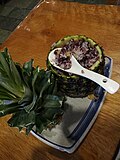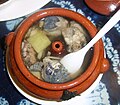Yunnan cuisine
Culinary traditions of Yunnan From Wikipedia, the free encyclopedia
Yunnan cuisine, alternatively known as Dian cuisine, is an amalgam of the cuisines of the Han Chinese and other ethnic minority groups in Yunnan Province in southwestern China. As the province with the largest number of ethnic minority groups, Yunnan cuisine is vastly varied, and it is difficult to make generalisations. Many Yunnan dishes are quite spicy, and mushrooms are featured prominently. Flowers, ferns, algae and insects may also be eaten. The cuisine of Yunnan is often compared to the cuisine of Southeast Asia as the province borders the region and many of the ethnic minorities or related cultural groups also have a presence in Southeast Asia.
This article needs additional citations for verification. (August 2015) |
| Yunnan cuisine | |||||||
|---|---|---|---|---|---|---|---|
| Traditional Chinese | 雲南菜 | ||||||
| Simplified Chinese | 云南菜 | ||||||
| |||||||
| Dian cuisine | |||||||
| Chinese | 滇菜 | ||||||
| |||||||




Three of the province's most famous products are the renowned Pu'er tea, which was traditionally grown in Ning'er; Xuanwei ham, which is often used to flavour stewed and braised foods in Chinese cuisine and for making the stocks and broths of many Chinese soups; and guoqiao (crossing the bridge), a rice noodle soup with chicken, pig's kidney and liver, fish and pickled pork.
Yunnan cuisine is unique in China for its cheeses like Rubing and Rushan cheese made by the Bai people. Other influences include Mongolian influence during the Yuan dynasty (i.e. Central Asian settlement in Yunnan), and the proximity and influence of India and Tibet on Yunnan.[1] Yunnan cuisine is gaining popularity in the west.[2] Likening the food vlogger Dianxi Xiaoge to the Chinese documentary television series A Bite of China, Xinhua said Dianxi Xiaoge could be called A Bite of Yunnan in introducing Yunnan cuisine to the world.[3]
Notable dishes
| Image | English | Traditional Chinese | Simplified Chinese | Pinyin | Origin | Description |
|---|---|---|---|---|---|---|
 | Baba | 粑粑 | 粑粑 | bābā | Naxi | A thick, round and heavy bread, either prepared plain or with various fillings. |
| Banana flower | 芭蕉花 | 芭蕉花 | bājiāo huā | Dai/Zhuang people | The heart of the banana flower. Frequently eaten roasted in banana leaves on an open barbecue, but also stir-fried. | |
 | Pineapple rice | 菠蘿飯 | 菠萝饭 | bōluó fàn | Dai people | Pineapple rice. It is found in Xishuangbanna and other areas populated by Dai people. |
 | Erkuai | 餌塊 | 饵块 | ěrkuài | Bai people (Dali Prefecture) | Highly refined and compressed rice cakes. |
 | Crossing the bridge noodles | 過橋米線 | 过桥米线 | guò qiáo mǐxiàn | Han Chinese | Literally means "crossing the bridge noodles" or "across the bridge noodles". It is Yunnan's best known dish. It typically consists of a bowl of boiling chicken soup, to which diners add their own selection of thin meat slices, mixian, vegetables and spices, much like a hot pot. It is ubiquitous throughout the province. |
| Adzuki beans | 紅豆 | 红豆 | hóngdòu | Adzuki beans have been used in Yunnan for millennia. Earliest domesticated examples are known from tombs in Japan (4,000 BCE), then China and Korea (3,000 BCE). Genetic evidence indicates that the bean later crossbred with native species in the Himalayas, and Yunnan was probably exposed to the ingredient at the time. Frequently prepared fried with kale or mint. | ||
 | Jidou liangfen | 雞豆涼粉 | 鸡豆凉粉 | jīdòu liángfěn | Naxi people (Lijiang) | A savoury jelly made from gram flour. |
| Juecai | 蕨菜 | 蕨菜 | juécài | In high altitudes, often the first green growth in spring. | Immature fronds of bracken ferns, such as osmunda japonica.[4] Stir-fried or in soup. | |
 | Granny's potato | 老奶洋芋 | 老奶洋芋 | lǎonǎi yángyù | A local mashed potato style dish typically flavoured with spring onions and chilli. | |
 | Lufu | 滷腐 | 卤腐 | lǔfǔ | Northern China, via the Mongols (during the Yuan dynasty) | A type of fermented beancurd, typically used as a condiment or made into sauces, often used on erkuai. It is reddish-yellow in colour, with a soft texture and a savoury flavour. |
 | Migan / Mixian | 米干 / 米線 | 米干 / 米线 | mǐgàn / mǐxiàn | Dai people / Han Chinese | Fresh Yunnanese rice noodles, typically served either in a soup of broth or stir-fried. |
 | Nanpie | 喃撇 | nanpiě | Dai people.[5] | Sauce-like dish made with fresh ingredients and spices. | |
| Peanuts | 花生 | 花生 | huāshēng | Re-introduction?[6][7] | Eaten fried as a condiment, as a component in fried noodles, cold noodles, noodle soups, stir-fries and fried rice. | |
 | Pu'er tea | 普洱茶 | 普洱茶 | pǔ'ěr chá | Han Chinese (Ning'er) | Famous dark tea that had gained popularity worldwide for its health benefits. |
 | Steam pot chicken | 氣鍋雞 | 气锅鸡 | qì guō jī | Han Chinese (Jianshui) | Literally means "steam pot chicken". It consists of chicken steamed with tonics and herbs in a ceramic pot. |
 | Rubing | 乳餅 | 乳饼 | rǔbǐng | Bai people (Dali Prefecture) | Cheese made from goat's milk. |
 | Rushan | 乳扇 | 乳扇 | rǔshān | Bai people (Dali Prefecture) | Cheese made from cow's milk. |
 | Shiping tofu | 石屏豆腐 | 石屏豆腐 | shípíng dòufǔ | Han Chinese via the Mongols (Shiping) | Traditional bean curd made in Shiping County, dating from the Yuan dynasty. |
| Xuanwei ham | 宣威腿 | 宣威腿 | Xuānwēi tuǐ | Han Chinese (Qujing) | Traditional ham made in Xuanwei, a county-level city in Qujing. It dates from the Ming dynasty. | |
 | Yiliang roast duck | 宜良烤鴨 | 宜良烤鸭 | yíliáng kǎoyā | Han Chinese (Yiliang) | A crispy skin roast duck similar to Peking duck, but honey is used to crisp and colour the skin. It is roasted with pine branches and needles, which impart a unique flavour to the dish. |
 | Zhe'ergen | 折耳根 | 折耳根 | zhé'ěrgēn | Yelang | An edible rhizome with a fresh, spicy and peppery flavour. The leaves are also eaten. |
 |
Da jiu-jia | 大救駕 | 大救驾 | Tengchong | Chinese stir-fry that consists of Erkuai cut into thin slices before being fried with pork, egg, soy sauce, and vegetables | |
| Crisp stuffed bun | 破酥包 | 破酥包 | pòsūbāo | Han Chinese | A lard-layered bun with pork, lard, bamboo shoot, and soy sauce; or with the filling of Yunnan ham and white sugar or brown sugar. Poshu Bun was created by a chef from Yuxi almost a hundred years ago. |
Characteristic features
Summarize
Perspective
Abundant ecological raw materials
Yunnan is located in the Yunnan-Guizhou plateau, with an extended range of mountains, plains, and lakes, forming a colorful scenery and three-dimensional climate of tropical, subtropical, temperate, and cold zones.[8] This kind of diverse physiognomy and environment are beneficial to the growth of a variety of plants and animals. Yunnan is known as the "fungus kingdom," "plant kingdom," and "animal kingdom."[9] It is one of the regions with the most abundant edible wild fungus resources in China. There are more than 250 kinds of edible native fungus, among which common ones are bovine liver fungus, Qingtou fungus, chicken fir fungus, dried fungus, bamboo sun fungus, matsutake fungus and so on.
Unique cooking technique
The cooking technique is an essential factor in cooking dishes. Many dishes are unique in their varied use of cooking utensils, fire, flavors, and colors. Yunnan is known for its diversity and ethnic minorities. The ancient cooking methods of 25 ethnic minorities found in Yunnan are merging with the cooking techniques of the Han nationality, which makes Yunnan cuisine uniquely flavorsome and colorful. In the province, the Han peoples' techniques of steaming, frying, sautéeing (with starch extract), braising, quick-boiling, boiling, and stewing are melding with the methods of minority techniques of baking, grinding with mortar and pestle, heat-contact, curing, cooking on stone, preserving with salt and other cooking methods.[10]
For example:

- Bamboo rice: Adding glutinous rice into bamboo to make bamboo rice with soft and glutinous fragrance.
- Pineapple rice: Pineapple purple rice made with hollowed pineapple with fragrant pineapple flavor.
- Steamed chicken: Steamed chicken made with Jianshui purple pottery special steam cooker with original flavor.
See also
References
Wikiwand - on
Seamless Wikipedia browsing. On steroids.
